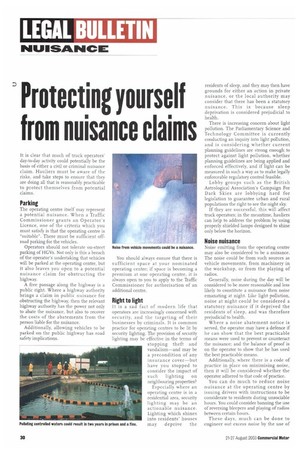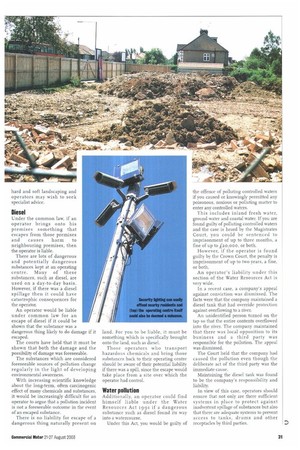Protecting yourself from nuisance claims
Page 30

Page 31

If you've noticed an error in this article please click here to report it so we can fix it.
It is clear that much of truck operators' day-to-day activity could potentially be the basis of either a civil or criminal nuisance claim. Hauliers must be aware of the risks, and take steps to ensure that they are doing all that is reasonably practicable to protect themselves from potential claims.
Parking
The operating centre itself may represent a potential nuisance. When a Traffic Commissioner grants an Operator's Licence, one of the criteria which you must satisfy is that the operating centre is "suitable". There must be sufficient offroad parking for the vehicles.
Operators should not tolerate on-street parking of HGVs. Not only is this a breach of the operator's undertaking that vehicles will be parked at the operating centre, but it also leaves you open to a potential nuisance claim for obstructing the highway.
A free passage along the highway is a public right. Where a highway authority brings a claim in public nuisance for obstructing the highway, then the relevant highway authority has the power not only to abate the nuisance, but also to recover the costs of the abatements from the person liable for the nuisance, Additionally, allowing vehicles to be parked on the public highway has road safety implications. You should always ensure that there is sufficient space at your nominated operating centre; if space is becoming a premium at one operating centre, it is always open to you to apply to the Traffic Commissioner for authorisation of an additional centre.
Right to light
It is a sad fact of modern life that operators are increasingly concerned with security, and the targeting of their businesses by criminals. It is common practice for operating centres to be lit by security lighting. The provision of security lighting may be effective in the terms of stopping theft and vandalism—and may be a precondition of any insurance cover—but have you stopped to consider the impact of such lighting on neighbouring properties?
Especially where an operating centre is in a residential area, security lighting may be an actionable nuisance. Lighting which shines into residents' houses may deprive the residents of sleep, and they may then have grounds for either an action in private nuisance, or the local authority may consider that there has been a statutory nuisance. This is because sleep deprivation is considered prejudicial to health.
There is increasing concern about light pollution. The Parliamentary Science and Technology Committee is currently conducting an inquiry into light pollution, and is considering whether current planning guidelines are strong enough to protect against light pollution, whether planning guidelines are being applied and enforced effectively, and if light can be measured in such a way as to make legally enforceable regulatory control feasible.
Lobby groups such as the British Astrological Association's Campaign For Dark Skies are lobbying hard for legislation to guarantee urban and rural populations the right to see the night sky.
If they are successful, this will affect truck operators; in the meantime, hauliers can help to address the problem by using properly shielded lamps designed to shine only below the horizon.
Noise nuisance
Noise emitting from the operating centre may also be considered to be a nuisance. The noise could be from such sources as vehicle movements, from machinery in the workshop, or from the playing of radios.
Generally, noise during the day will be considered to be more reasonable and less likely to constitute a nuisance then noise emanating at night. Like light pollution, noise at night could be considered a statutory nuisance if it deprived the residents of sleep, and was therefore prejudicial to health.
Where a noise abatement notice is served, the operator may have a defence if he can show that the best practicable means were used to prevent or counteract the nuisance; and the balance of proof is on the operator to show that he has used the best practicable means.
Additionally, where there is a code of practice in place on minimising noise, then it will be considered whether the operator adhered to that code of practice.
You can do much to reduce noise nuisance at the operating centre by issuing drivers with instructions to be considerate to residents during unsociable hours. You could consider banning the use of reversing bleepers and playing of radios between certain hours.
These days, much can be done to engineer out excess noise by the use of hard and soft landscaping and operators may wish to seek specialist advice.
Diesel
Under the common law, if an operator brings onto his premises something that escapes from those premises and causes harm to neighbouring premises, then the operator is liable.
There are lots of dangerous and potentially dangerous substances kept at an operating centre. Many of these substances, such as diesel, are used on a day-to-day basis. However, if there was a diesel spillage then it could have catastrophic consequences for the operator.
An operator would be liable under common law for an escape of diesel if it could be shown that the substance was a dangerous thing likely to do damage if it escaped.
The courts have held that it must be shown that both the damage and the possibility of damage was foreseeable.
The substances which are considered foreseeable sources of pollution change regularly in the light of developing environmental awareness.
With increasing scientific knowledge about the long-term, often carcinogenic effect of many chemicals and substances, it would be increasingly difficult for an operator to argue that a pollution incident is not a foreseeable outcome in the event of an escaped substance.
There is no liability for escape of a dangerous thing naturally present on land. For you to be liable, it must be something which is specifically brought onto the land, such as diesel.
Those operators who transport hazardous chemicals and bring those substances back to their operating centre should be aware of their potential liability if there was a spill, since the escape would take place from a site over which the operator had control.
Water pollution
Additionally, an operator could find himself liable under the Water Resources Act 1991 if a dangerous substance such as diesel found its way into a watercourse.
Under this Act, you would be guilty of the offence of polluting controlled waters if you caused or knowingly permitted any poisonous, noxious or polluting matter to enter any controlled waters.
This includes inland fresh water, ground water and coastal water. If you are found guilty of polluting controlled waters and the case is heard by the Magistrates Court, you could be sentenced to imprisonment of up to three months, a fine of up to Z20,000, or both.
However, if the operator is found guilty by the Crown Court, the penalty is imprisonment of up to two years, a fine, or both.
An operator's liability under this section of the Water Resources Act is very wide.
In a recent case, a company's appeal against conviction was dismissed. The facts were that the company maintained a diesel tank that had override protection against overflowing to a river.
An unidentified person turned on the tap so that the entire contents overflowed into the river. The company maintained that there was local opposition to its business and a third party was responsible for the pollution. The appeal was dismissed.
The Court held that the company had caused the pollution even though the deliberate act of the third party was the immediate cause.
Maintaining the diesel tank was found to be the company's responsibility and liability.
In view of this case, operators should ensure that not only are there sufficient systems in place to protect against inadvertent spillage of substances but also that there are adequate systems to prevent access to tanks, drums and other receptacles by third parties.
































































































































































